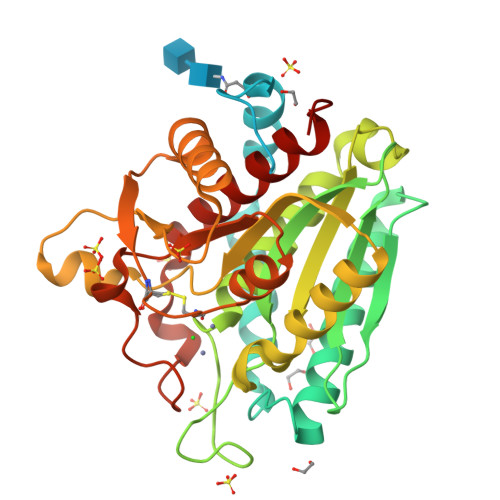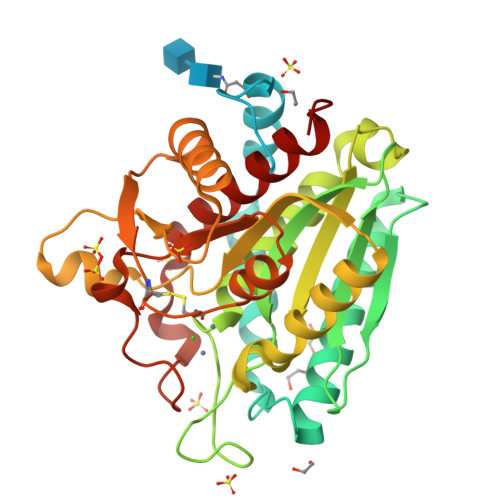The role of propeptide-mediated autoinhibition and intermolecular chaperone in the maturation of cognate catalytic domain in leucine aminopeptidase.
Baltulionis, G., Blight, M., Robin, A., Charalampopoulos, D., Watson, K.A.(2021) J Struct Biol 213: 107741-107741
- PubMed: 33989771
- DOI: https://doi.org/10.1016/j.jsb.2021.107741
- Primary Citation of Related Structures:
6ZEP, 6ZEQ, 7OEZ - PubMed Abstract:
Leucyl aminopeptidase A from Aspergillus oryzae RIB40 (AO-LapA) is an exo-acting peptidase, widely utilised in food debittering applications. AO-LapA is secreted as a zymogen by the host and requires enzymatic cleavage of the autoinhibitory propeptide to reveal its full activity. Scarcity of structural data of zymogen aminopeptidases hampers a better understanding of the details of their molecular action of autoinhibition and how this might be utilised to improve the properties of such enzymes by recombinant methods for more effective bioprocessing. To address this gap in the literature, herein we report high-resolution crystal structures of recombinantly expressed AO-LapA precursor (AO-proLapA), mature LapA (AO-mLapA) and AO-mLapA complexed with reaction product l-leucine (AO-mLapA-Leu), all purified from Pichia pastoris culture supernatant. Our structures reveal a plausible molecular mechanism of LapA catalytic domain autoinhibition by propeptide and highlights the role of intramolecular chaperone (IMC). Our data suggest an absolute requirement for IMC in the maturation of cognate catalytic domain of AO-LapA. This observation is reinforced by our expression and refolding data of catalytic domain only (AO-refLapA) from Escherichia coli inclusion bodies, revealing a limited active conformation. Our work supports the notion that known synthetic aminopeptidase inhibitors and substrates mimic key polar contacts between propeptide and corresponding catalytic domain, demonstrated in our AO-proLapA zymogen crystal structure. Furthermore, understanding the atomic details of the autoinhibitory mechanism of cognate catalytic domains by native propeptides has wider reaching implications toward synthetic production of more effective inhibitors of bimetallic aminopeptidases and other dizinc enzymes that share an analogous reaction mechanism.
Organizational Affiliation:
School of Biological Science, Whiteknights Campus, University of Reading, RG6 6AS, UK; Department of Food and Nutritional Sciences, Whiteknights Campus, University of Reading, RG6 6AS, UK.





















